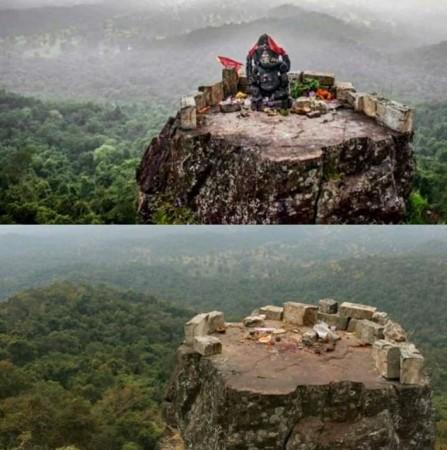
Maoists, who are supposedly fighting for the rights of the tribals, have allegedly turned to vandalism, venting their anger on a 1,000-year-old Hindu God Ganesha's idol by pushing it down a 13,000 feet mountain on Friday. The idol was situated atop the Dholkal mountain in Dantewada district, Chhattisgarh.
Read: In a first, Indian paramilitary force deploys women commandos for operations against Maoists
The vandalised idol was found by authorities at the bottom of the hill, broken into 56 pieces.
The police immediately suspected the handiwork of Maoists, who have been active in the dense forest area in Dantewada district. The Maoists were "frustrated" with the frequent movement of tourists and devotees to the place, the Hindustan Times reported. Informers had tipped the police about frustration of the ultras with the influx of tourists and devotees.
The police have started their investigation, but prima facie evidence points to the involvement of Maoists. Villagers had witnessed their movement on the mountain range some days back.
Some youths who visited the place on Thursday reported that the idol was missing and posted pictures of it on the social media. Taking cognisance of these images, the local authorities and administration soon rushed to the area with a police team.
"During the search, the broken idol was found lying at around 1,000 feet down the hilltop. Probably it was pushed down from its place," said Saurabh Kumar, Dantewada collector to PTI.
Dandewada is a hotbed of left-wing extremism.
The Ganesha idol
The Ganesha idol was 4-feet tall and made out of granite during the Nagvanshi dynasty in the 9th or 10th century. The idol weighed over 500 kg and sat atop the mountain that is in the shape of 'dhol,' an Indian percussion instrument.
Hindus believe Ganesha to be a remover of obstacles and a patron of travellers.

Discovery of the place
According to Times of India, the idol was discovered by a local journalist in September 2012. Later, Chhattisgarh archaeology department formed a committee to conduct a survey of the place.
However, the place was first discovered by an English geologist Crookshank in 1934 during the Bailadila mining survey.
The place is nestled among dense forest and the routes to reach atop are unforgiving.
The mountain range is 14km deep inside the forest and the nearest police station is 450km away.
Adventurists find the place ideal for trekking and the state government is also keen to cash in on the tourism potential of the area.
The Maoists try to disrupt any meaningful development in the areas under their hold. Moreover, the recent demonetisation drive of the central government is said to have suffocated many left-wing extremists and their sympathisers.
In November alone, nearly 564 Maoists and their sympathisers surrendered and many have been caught converting the old currency with new ones, said Times of India.
Social Media reaction
Wonder if #Moist has turned to #iconoclasm. Destroyed 1000 yr old #GaneshaIdol in #bastar at #Dholkal hill @Arshi_Anwar @PunjabiRooh pic.twitter.com/hPRJQF93Xd
— Authindia (@authindia) January 28, 2017
1000 year old Ganesha idol destroyed. Our History erased! Shocking and deeply saddening :( #Dholkal #Ganesha
— seekingtheoblivion (@swathyg) January 28, 2017
Will We Ever Learn To Protect Our Archaeological Heritage ? #Dholkal #Ganesha
— indianhistorypics (@IndiaHistorypic) January 27, 2017














